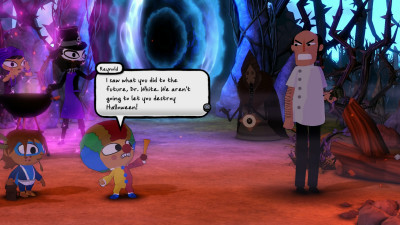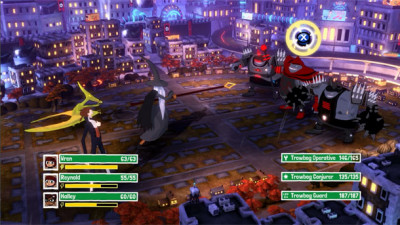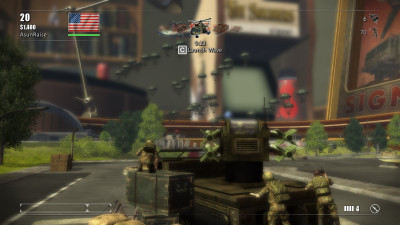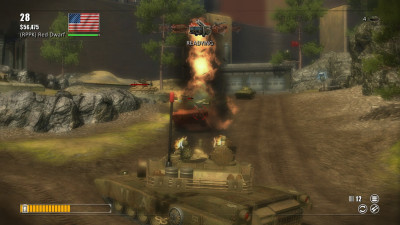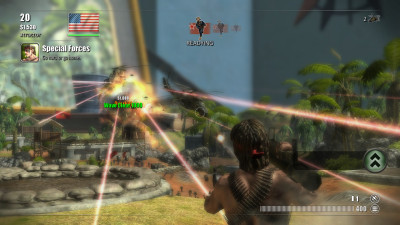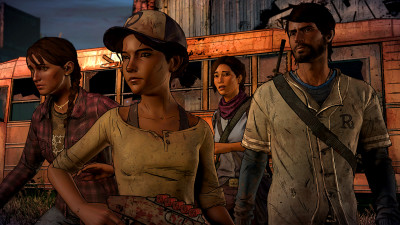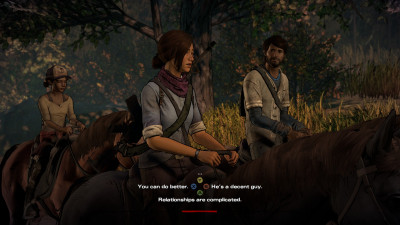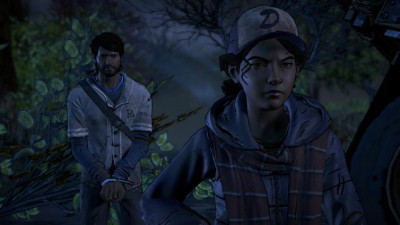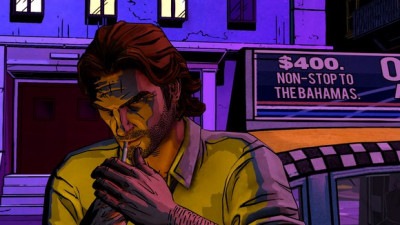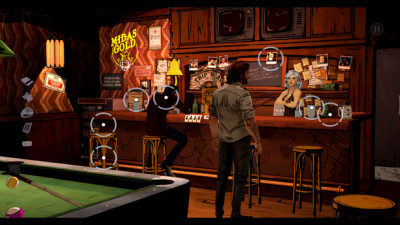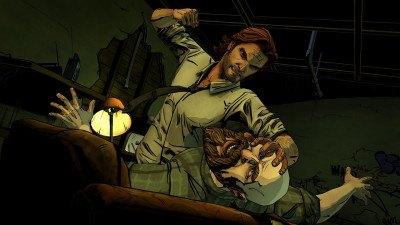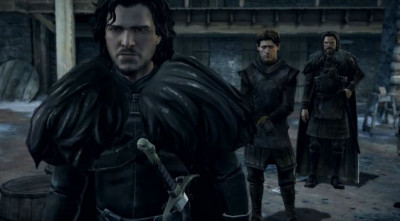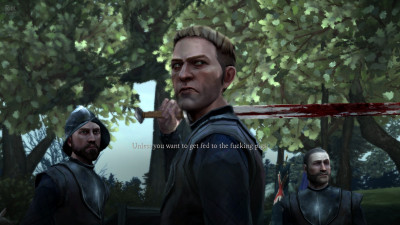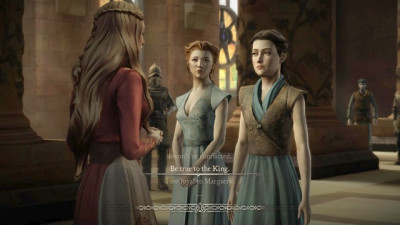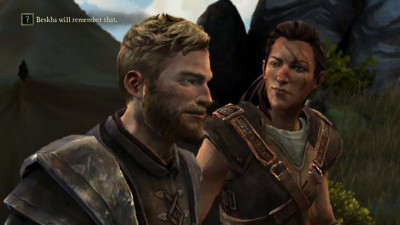I’ve been intrigued by Firewatch since it was first announced. Not only have I been a longtime fan of many of the the Idle Thumbs podcasts, of which three members are key Campo Santo employees, but I loved The Walking Dead, and two of those three employees were its project leads and writers. I’ve also enjoyed my few forays into the “walking simulator” genre thus far, and the previews of the game made the basic themes look appealing as well. Despite buying it on PC the first time it ever went on sale on Steam, I only finally got around to playing it last month, buying the Xbox One version so I could more easily share the experience with my girlfriend from the comfort of our living room couch.
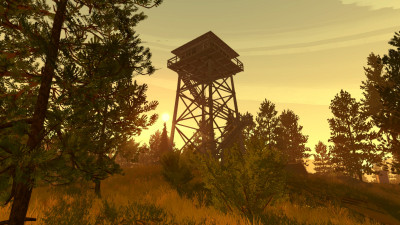
“Home sweet home.”
Right off the bat Firewatch hits you with a bizarre “choose your own adventure” like interactive story about your character Henry’s backstory. A bit jarring, it feels a little low budget and isn’t anything like the experience I was gearing myself up for. Still, it has an interesting function – you immediately start the game with a good idea of who your character is, what he’s gone through, and having customized his backstory a little in the process, even a bit of a connection to him.
Once in the game proper, you find Henry in the beautiful Wyoming wilderness where he’ll be manning a fire tower for the season. We have fire lookout towers not too dissimilar to the ones featured in Firewatch out here in and around the southern Appalachian Mountains and, having had the opportunity to climb several of them over the years, I’ve always been fascinated by what manning one of them must have been like back when they were in full-use. The Campo Santo team did a fabulous job bringing those towers and the surrounding wilderness to life. The stylized art and the engine’s lighting system steal the show, but it all comes together just perfectly, producing beautiful vistas filled with swaying trees and grass among rolling hills and rocky peaks. Combined with the forced first-person perspective and minimalist, mostly in-game-world UI, I quickly found myself totally immersed in the setting.
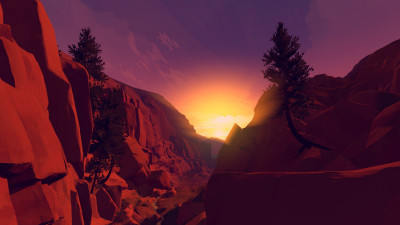
“The lighting really brings the whole presentation together.”
Firewatch’s world is fairly open, and while there is some gating and the occasional invisible wall, I never found them to take me too far out of the experience. This is likely because I was always too busy either checking out the amazing views, looking for the next interesting detail, or looking at my map and compass to try to figure out where in the hell I was. On top of that, I often felt a sense of urgency to try to complete my objectives before the sun went down and I’d be forced to wander my way back to my tower in near pitch-black darkness. Those objectives felt important to me most of the time too, so going off and exploring far beyond where I needed to be never made a lot of sense to me.
A lot of the user reviews I glanced at while writing this seemed to mention bugs and performance issues but for me the fact that the game ran so smoothly with such a degree of polish was absolutely a part of why I was able to really get into the experience. Maybe the Xbox One port is better than some of the others or perhaps I’m benefiting from being a late adopter here, but in any case, I think it bears mentioning that I didn’t have any such issues.
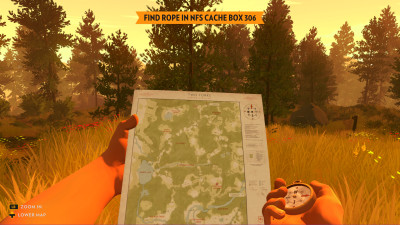
“I hope you like looking at maps!”
Anyway, so far, I’ve just described a game about a guy wandering around in the woods. Obviously, I’m leaving out a massive part of the game here: Delilah. Your character has a nearly-constant companion over the radio, something along the lines of Atlas helping you out in Bioshock, though a little less manipulative. The conversations between Henry and Delilah, both in terms of writing and voice acting, are what really push Firewatch into excellence. These chats are unusually funny, heartwarming, realistically written, and full of character. The dialog system has both the urgency of a Telltale adventure game, in which you might have a limited time to respond and your lack of a response is, in and of itself, interpreted as a response, and unlike most modern games with dialog systems, isn’t tied to story decisions or moral choices but mostly just serves to further develop your own personalization of the characterization of Henry. I can only guess that how well this all came together must have surprised even the developers themselves.
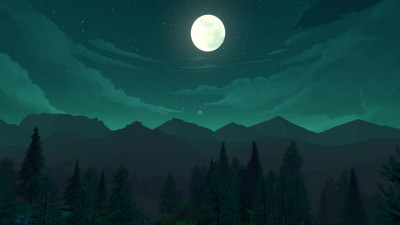
“I was more than a little disappointed about not having the option to order prints of my pictures in the Xbox One version.”
Through the friendship that grows between Henry and Delilah, the mysteries they unravel and personal baggage they unpack together, we eventually reach a conclusion that is, as with the dialog, rather realistic. I won’t spoil it or go into any in-depth analysis of the ending, despite how desperate I was to discuss it when first finishing the game, but I will say that like so many others I was a bit disappointed in the ending. At the same time, I felt like I understood, at some very deep emotional level, what Campo Santo was aiming to achieve, and I got it. I got it. I didn’t like it, maybe because it was a bit too real, but in some way, it made me respect the entire experience all the more for it. What a fantastic game.
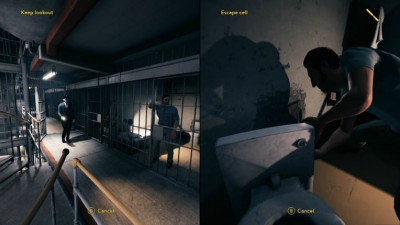
“One player distracts the guard, the other unclogs the toilet.”
At some point while playing Firewatch we stumbled upon A Way Out in the Microsoft Store. From watching trailers and listening to some podcast banter about it, all I really knew was that it was a game about two convicts working together to escape a prison, and that the whole game was based around being a two-person co-op experience. I could also see that the game looked fantastic, with a simplified but realistic art style, and a lot of interesting, very cinematic camera work. Overall the art and presentation is somewhat reminiscent of the last couple of Grand Theft Auto titles, which is a good thing.
Starting the game, we found ourselves quickly engaged, as we had to decide which of the two distinct characters we’d want to play and then, after a brief cutscene, were set off on two different paths. The fact the game starts off with your two characters not even knowing each other was unexpected, and despite the beginning being a little slow, made for some interesting development as the two characters met and the story progressed.
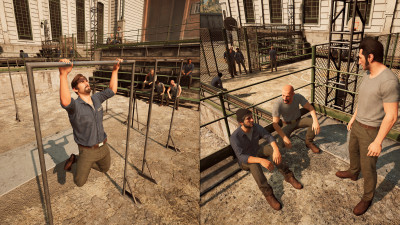
“Wandering the yard.”
Having each player working on separate goals via split-screen, interspersed by the occasional use of clever timing to trigger cutscenes and events involving both characters together is the game’s central novelty, in fact. Sometimes these events are little mini-games meant to allow the players to interact and the characters to bond a bit, and other times they’re simple cooperative puzzles, like needing both players’ input to lift a heavy object or to climb up an otherwise unreachable ledge. Occasionally the players must decide between two different approaches to solving a situation, which was kind of cool. I do wish there was a little more depth to these mechanics, as your interactions with NPCs are short and mostly only serve as fluff, the exploration is very limited, and the cooperative puzzles are almost all exceedingly basic. I suppose the simplicity is in service of being an approachable co-op experience, so I can largely overlook that. Besides, early on, it was mainly the story and the characters that had me hooked.
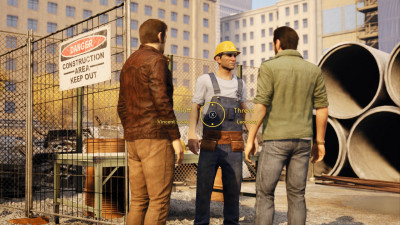
“You can choose to handle a lot of situation Leo’s way, or Vincent’s way. You’ll figure out what that means quite quickly.”
Unfortunately, the story is really nothing too special. The fact that almost every aspect of it was swiped from genre tropes is a common complaint but I personally didn’t really find that to be distracting or problematic. Instead, my main problem is that while the game does a good job at giving you a sense of who both characters are, in fact watching them interact as the story unfolded really seemed like it was going to be something very special, it ends up squandering the opportunity for some real character development and an impactful story. This is especially true when the plot takes a sharp turn from being about our characters escaping prison and reuniting with their families to being about them seeking revenge on the person who put them there. It just goes a bit off the rails.
Revenge certainly could have been an interesting angle, of course, but when the game suddenly devolved from what felt more like a narrative heavy adventure game, not completely dissimilar to the aforementioned Firewatch, into a mediocre third person shooter, it kind of lost me. By this point in the story we had learned that neither one of our two characters were what you’d call “violent criminals” yet they suddenly engage in the wanton slaughter that makes up this next to last scene of the game without batting an eye. Talk about ludonarrative dissonance! That, and the twist at the end, while mechanically kind of cool, just wasn’t at all where I felt like the story was taking me early on.
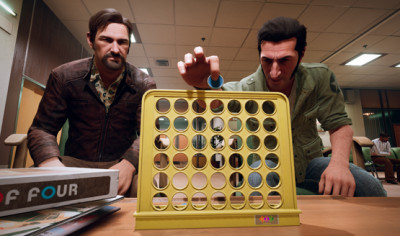
“There’s always time for Connect 4!”
Despite the disappointing finale, I liked A Way Out overall. The presentation, the characters, and the co-op centric gameplay really impressed, even if my great early impressions didn’t quite last throughout the game. There aren’t a lot of games out there that rely on cooperative gameplay, especially split-screen cooperative gameplay, and A Way Out even lets a second person play online without owning the game, which is awesome! If the negatives in this little review here don’t sound like they’d outweigh the positives for you then it is probably easily worth your money. At the very least, Hazelight Studios’ next project will have my full attention. I hope it’s not something entirely different as I really do see a lot of potential in A Way Out’s style of gameplay.
As usual, I’ve stolen my Xbox One screenshots from aimlessly scouring the Internet for decent ones. Apologies for not having individual credits for each of them!
